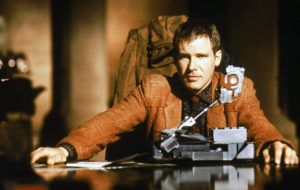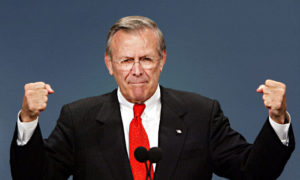American history can best be understood not as a single continuum but as a series of Republics, each arising from the ashes of its predecessor. The First Republic, born of the American Revolution, ended with Andrew Jackson’s Trumpian assault on the genteel elites of his day. Jackson’s Republic in turn collapsed into the fratricidal bloodshed of the Civil War, which gave birth to a Third Republic, ruled by an incredibly wealthy class of Northern-based industrial capitalists, which collapsed in the face of the Great Depression. The Fourth Republic, Franklin Roosevelt’s, was centred around the strong Federal state that won the Second World War, sent men to the moon, and overcame the rival Soviet empire.
Whether Roosevelt’s Republic properly ended with the social chaos of the late Sixties or with America’s victory in the Cold War, and whether we are therefore currently living in the Fifth, Sixth or arguably even the Seventh American Republic, is the type of question that future history students in Beijing or Singapore are bound to contemplate on their final exams. The more immediate point is that another American Republic is collapsing, and also that we’ve been here before. In recent years, as in the Sixties, we’ve seen the take-over of large sections of American cities by armies of drug-addicted zombies, riots in Washington, dirty political tricks by the FBI and the CIA, the capture of universities by militants obsessed with race and gender, dire warnings about the fate of the planet, and the wholesale abandonment of American military allies. The difference between now and the Sixties is that today the people with Angela Davis posters on their walls are living in gated communities, rather than communes.
More troublesome, however, than the sight of America once again shedding its skin, is the shape of the American Republic to come — and the question of whether it will be a republic at all. Since the end of the Cold War, America has transformed itself from a country in which most citizens proudly imagined themselves to be “middle class” into a bi-coastal oligarchy. The hallmarks of this new republic’s politics are the sorts of pathologies that used to be associated with the countries to America’s south: a wildly unequal distribution of wealth, choking bureaucracy, paranoid mass politics, the weaponisation of the security apparatus, and the merger of monopoly capital and invasive state bureaucracies.
The beginning of the current crisis can be dated to the election of 2016, in which a large majority of voters expressed their rejection of the American socio-political order by voting for either Bernie Sanders or Donald Trump over the neoliberal establishment candidate, Hillary Clinton. Trump’s election was followed by coordinated attacks on his flailing presidency by large sections of the American power structure, including the national press, corporate monopoly internet platforms, and a security apparatus that used the press as a megaphone for a series of conspiracy theories and lies that were often spread under cover of anonymity. The media’s already-tattered credibility with the public was plunged into the toilet.
This toxic combination of widening political polarisation and institutional failures was contaminated further by the country’s disastrous response to Covid-19, which crushed small and medium-sized businesses while padding the profits of large investors and internet-based monopolists. The result was the largest single transfer of wealth in American history since the Civil War, and the disenfranchisement of a significant portion of the American middle class — accompanied by a steady drum-beat of “woke” discourse that gleefully demonised the losers as “white supremacists” and “insurrectionists”.
The election of Joe Biden in 2020 was supposed to restore the legitimacy of the American political system and bring a measure of social peace. Instead, President Biden went in the opposite direction, attacking his opponents as “white supremacists” and “fascists”, setting the FBI on domestic foes, and endorsing a banana republic-style raid on Trump’s home.
Yet to blame America’s woes on either the 79-year old Biden, who strikes even sympathetic domestic observers as senile, or Trump, who continues to be a font of ugly and delusional politics, is to dangerously mistake the nature of the crisis. America’s toxic partisan politics are a symptom of deep changes in the American socio-economic structure that date back to the early Nineties, in the aftermath of America’s victory in the Cold War — when President Bill Clinton set out to take Reaganomics global with a series of trade deals that included NAFTA and GATT, and destroyed the American middle class that Roosevelt and his successors created.
From the standpoint of the Democratic Party of the Nineties, Clinton’s trade deals were a huge success, bringing major sectors of Wall Street and large American corporations into the party camp. For traditional Democratic constituencies such as industrial labour unions and their members, they were a disaster, permanently depriving millions of Americans of their jobs and turning large swaths of the country’s industrial base into rubble-strewn reservations for zombified meth-heads.
Among the writers, thinkers, and reporters who tried to analyse the travails of the American working and middle classes during Bill Clinton’s presidency, perhaps the most acute was the Pentagon-linked geo-strategist Edward Luttwak. For Luttwak, the problem with America wasn’t market capitalism or the failure of American workers to compete with their peers in Mexico and China. Rather, it was the unholy conjunction of Right-wing libertarian Reaganomics with selfish Left-wing baby boomer mantras about free trade, technology, and open borders.
What both the Left and the Right shared, in Luttwak’s analysis, was their disdain for the kinds of Bismarckian social bargains that keep states strong. Luttwak called the unholy alliance of the libertarian Left and Right “Turbo-Capitalism”, and he warned of its disintegrating effects on the American middle class, which he saw as the foundation-stone of American stability, prosperity, and geo-political dominance.
In his concern for the disintegrating American middle class of the Nineties, Luttwak was hardly alone. The troubles of middle-and-working-class Americans were a common theme during that era among a cohort of perceptive American thinkers including Robert Bellah, Barbara Ehrenreich, Michael Lind, Robert Putnam, and Robert Reich. What made Luttwak a rarity among his peers, Lind excepted, was his embrace of European-style welfare state capitalism in the context of an overtly nationalist politics — ie the American status quo before the Reaganites and the Clintonites set out from different directions to destroy it.
The America of the Obama-Trump-Biden years now looks a lot worse than the America that alarmed Luttwak and Lind in the Nineties. At the top of the narrowing social pyramid is a tiny class of mega-billionaires who personally own and control a staggering percentage of the country’s wealth, resources, and power, and make their money from the globalised economy. Then comes the professional class that services the billionaires, ranging from highly paid lawyers and investment bankers to chefs and fashion designers and real estate salesmen. Below them is the servant class of bureaucrats, teachers and other lower-status employees whose salaries are paid by the state or non-governmental organisations and foundations, who funnel money back to their political patrons in the Democratic Party in the form of free campaign labour and contributions.
Finally, there are the working poor, many of whom formerly considered themselves “working class” or “middle class”, but who are now forced to rely on government programs and subsidies covering everything from rent, to school tuition, to health care, to food. The glue that holds this power vertical together is the Democratic Party, which now regularly outspends the Republican Party — an incoherent mix of Trumpists, Christians, and other socio-economic losers — by margins of three or four to one.
In addition to being an oligarchy, the new American social pyramid is also a gerontocracy, in which both political power and wealth are wildly skewed in favour of people above the age of 60. Biden (79) and Nancy Pelosi (82) lead the Democrats, while Trump (76) and Mitch McConnell (80) lead the Republicans. Where the average American over the age of 55 has a net worth of somewhere between $1.2 and $1.5 million, the average American adult under the age of 35 is worth approximately $75,000, with the vast majority having no significant assets at all.
Understanding the new America as a decaying oligarchy run by old people is essential to understanding the increasingly bizarre mutations of Left and Right in American politics. The “Left”, in the United States, now represents the new oligarchy and its dependents. The resulting “Left-wing” preferences for free trade and open borders in turn make it impossible for American workers to earn a living wage. The fact that the new American Left is funded by billionaires such as George Soros (92) and Warren Buffet (91) ensures that Left politics is focused not on decent pay for workers but on the ever-mutating math of woke identity politics.
In place of tangible goods, such as a living wage and the chance to buy a home, groups of dispossessed Americans are offered official “recognition” of an ever-expanding set of “identities” rooted in race, gender and sexual preference, which pits them against other groups of Americans who suffer from much the same woes. Wokeness, as an ideology, can be seen as a function of the ascendent Turbo-Capitalist order — a means for controlling the working and middle classes to ensure that they can’t unite against their increasingly all-powerful masters.
The digital technologies on which the new American mega-fortunes are based offer historically unprecedented opportunities for surveillance, censorship, and social control — and have allowed the oligarchs who own them to merge with the state. Jeff Bezos of Amazon, for example, owns the Washington Post, which the security apparatus used as a megaphone to spread the Russiagate conspiracy theory to undermine Trump. Amazon also holds a lucrative cloud computing contract to manage all the CIA’s data, which it administers from a centre in Northern Virginia where over 20,000 people work, many of whom were formerly employed by the government. While tech giants such as Oracle and Palantir have large contracts with the US security apparatus, public-facing companies such as Facebook, Google, and Twitter regularly censor news and opinions at the behest of the White House while funneling private user data to the security services for free.
If techno-monopolists have merged with the security bureaucracies in Washington, the human instrument of elite control is the “professional-managerial class”, which forms the backbone of the lay Democratic Party. But how did this relatively narrow group of lawyers, professors, teachers, nonprofit workers, bureaucrats, and lower-level editors gain the power to anathemise, exclude, condemn, and generally lord it over much larger sectors of the population?
One answer is its ability to leverage digital tools, particularly social media — a medium in which small numbers of activists can wreak havoc on hundred-billion-dollar corporations or prestige institutions. By this logic, the Woke is a vanguard movement that seized control of a new technology and used it as a force multiplier to discipline and terrorise the larger institutional landscape.
A more subtle version of this answer is that woke-ists use the threat of reputational damage to impose uniformity of opinion on the class of people like themselves, whose careers exist only insofar as they are backed by sufficient reputational capital. Unlike previously dominant forms of capital (like, say, land and cows), the reputational capital that is the professional class’s stock in trade — the ticket to the next job or fellowship — can be vaporised by a single tweet. In turn, the uniformity of opinion that the woke imposes within its own cohorts allows it to control those cohorts, and use them to bend powerful institutions to its will.
This explanation of wokeness, though, is to imagine that the tail is wagging the dog. But, media companies have stockholders, just as universities have wealthy and powerful trustees to answer to. These stockholders and trustees should be more powerful than broke 20-somethings with Twitter accounts. Surely, at some point, market forces should begin to punish institutions that chose to ignore reality. If Princeton University, say, were to embark on a programme of persecuting faculty who dissent from faddish doctrines, then those faculty members — and the donors who support them — could migrate to Harvard, which would accumulate money and prestige at Princeton’s expense. But that never happens. Not just institutions of higher education, the entire professional layer of society — from the professions, to corporate management, to non-profits, to media and publishing — moves in lock-step.
So who does control the new American system? The answer isn’t broke woke-ists. It’s the monopolists who own the platforms where the woke-ists live. Elon Musk and Bill Gates and Jeff Bezos and Warren Buffett and Sergei Brin and Larry Page and Lorraine Jobs don’t care about mean tweets. They care about the hundreds of billions of dollars in their bank accounts, their lavish mansions and private jets, and pursuing rich person hobbies like colonising Mars. Their primary political goal, as a class, is to prevent the state from ever getting strong enough to tax their fortunes, break up their monopolies, or interfere with the supplies of cheap immigrant and offshore labour from which they profit. The more fractured, dejected, and heavily surveilled the America public is, the less likely a strong state is to emerge.
In the contest between the oligarchs and the fading Rooseveltian state, the woke are a useful tool— not an independent power. They are the foot soldiers of the Democratic Party, whose job it is to organise the dispossessed into groups that are narrow, factional, and divided enough that they can’t come together into a force that threatens oligarchical control. Discontent with the Turbo-Capitalist order can be usefully turned against anyone who refuses to follow the ever-changing party line — beginning with the “deplorables” who are now regularly portrayed as murderous, undemocratic racists and fascists, and extending to JK Rowling and Margaret Atwood. The result is a closed circuit in which Turbo-Capitalist oligarchs and Woke activists make common cause against formerly independent institutions like universities, professional associations, and the press. All of these institutions rely on guarantees of individual and collective rights by the state, which the Turbo-Capitalists and the Woke seek to capture and use as an instrument to enforce their own privatised social bargain: everything within the Party, nothing outside the Party, nothing against the Party.
The unprecedented reach of the technologies that the new oligarchy commands has already destroyed the press and replaced it with a government-corporate censorship regime that has no parallel in peacetime America. Combined with what appears to be a healthy appetite for humiliating others, this power does not bode well for the future of social peace in America, or for the health of the next American Republic.
Disclaimer
Some of the posts we share are controversial and we do not necessarily agree with them in the whole extend. Sometimes we agree with the content or part of it but we do not agree with the narration or language. Nevertheless we find them somehow interesting, valuable and/or informative or we share them, because we strongly believe in freedom of speech, free press and journalism. We strongly encourage you to have a critical approach to all the content, do your own research and analysis to build your own opinion.
We would be glad to have your feedback.
Source: UnHerd Read the original article here: https://unherd.com/






